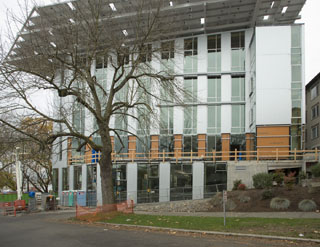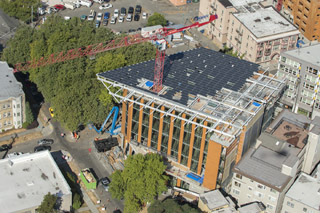|
Subscribe / Renew |
|
|
Contact Us |
|
| ► Subscribe to our Free Weekly Newsletter | |
| home | Welcome, sign in or click here to subscribe. | login |
Environment
| |
 |
November 29, 2012
A new prototype for urban green buildings
Miller Hull Partnership

Court
|
As architects we often find ourselves trying to coax clients into pursuing more efficient, environmentally responsible buildings.
With the Bullitt Foundation and its president, Denis Hayes, that clearly wasn’t the case, as the Bullitt Center was envisioned as a landmark prototype for green, urban buildings. Targeting the rigorous requirements of the Living Building Challenge green-building certification program, the Bullitt Center was projected to be twice as efficient as any building our firm had designed to date, at least on paper.
Albert Einstein famously noted that “we can’t solve problems using the same kind of thinking we used when we created them.” So keeping in mind that buildings in the U.S. consume about half our energy and are responsible for half of all carbon dioxide emissions, we understood from day one that the design process for the Bullitt Center would have to be adaptable and creative given the mandate to create a structure with essentially no environmental footprint.
To design a building that will serve as an example for others to learn from and improve upon, we wondered if we would have to change the way we design if we were going to create a better building. The outcome represents a new paradigm for our design process, changing how we seek to achieve enhanced performance balanced with beautiful design.
Integrated design process
The architect has historically operated on one end of a vertical design process that sometimes results in buildings that cost more and are less energy-efficient than they would be if engineers and other project partners were included in the design process.
For the Bullitt Center we implemented an integrated design process that enabled us to bring architects, engineers and contractors together from the beginning to develop a holistic design in keeping with our client’s uncompromising sustainability goals.
We soon realized that to power on site a six-story, 50,000-square-foot building, we were looking at what would have to be one of the most energy-efficient buildings ever designed.
The margin of error between the projected power supply and the demand was razor thin, which required that every design decision needed to get us closer to the net-zero energy goal. It was clear to us that the goals of the Bullitt Center were pushing us beyond merely an integrated design model into what we have come to refer to as performance-based design.
Performance-based design
Under this new design paradigm, formal moves are secondary to the optimization of building systems.
The massing of the building isn’t driven by metaphor or aesthetics but rather by performance metrics such as the quality of natural light and ventilation. The orientation and layout of the windows are driven by an even distribution of daylight on the interior rather than by the composition of the facades. Meeting the requirements of the Living Building Challenge means the selection of structural systems and materials is based on where they can be sourced and their relative carbon footprint.
If we design for performance first, what happens to the appearance, aesthetics and composition of the architecture? Typically we strive to design intelligent and efficient buildings that are conceptually clear and compelling. But in this case we were going to have to do more with less.
An integrated, performance-based design process overlaid with the Living Building Challenge gives us a building that is intelligent and does not deplete our resources, is more natural and less toxic, more regional and less global. But doing more with less doesn’t mean that our quality of life or the quality of the experience of our buildings have to be less. In fact, we feel it’s exactly the opposite.
Happily, we found that a performance-driven design process actually opens up new formal opportunities.
For example, the parallel projection windows installed at the Bullitt Center perform at a higher level for a longer period of time than other window systems, and fully automated retractable blinds control glare and block the heat before it warms up the building.
The combination of the automated blinds and efficient windows in turn provides an interesting, layered facade that adjusts through the course of a day while doing its job of modulating the interior environment. And the use of heavy timber framing helps reduce the building’s carbon footprint while leveraging the beauty of this natural regional material as a dramatic interior component.
Another prominent aspect of the design is the transparent staircase perched above Madison Street.
Denis Hayes requested an “irresistible stair” that would lure people out of the elevator — not just to save energy, but to ensure a healthier daily routine for building occupants and to foster a stronger sense of community within the building. With this feature, building performance is improved and we get a noteworthy vertical element on the building that animates the facade, connects building occupants inside and to the neighborhood, and provides spectacular views that keeps people climbing the stairs.
The roof of the Bullitt Center is perhaps its most defining element. Large roof overhangs have always been a part of the Pacific Northwest design vernacular, but in this case we could never have justified such a heroic roof if it weren’t purely for the generation of clean, renewable electricity.
While this was the most debated aspect of the building from a design point of view, it is worth pointing out that the rooftop photovoltaic arrays, while they might increase the perceived height or extent of the building, create electricity without the need for an externalized utility infrastructure — poles, wires, transmission towers — or the pollution associated with combustion.
We have also found the rigorous performance-based design process generates an architectural expression of interdependencies similar to what can be found in nature, with final building design expressive of the systems within, everything in its place in an organic, natural synthesis.
This reliance on performance to direct design is not to say that the architecture doesn’t matter. We still need to craft the expression of these systems and components in a compelling way with the parts organized to satisfy not only the science but the art of the building as well. While “form follows function” is more about programmatic solutions, performance-driven designs will have an elegant efficiency and simplicity.
Our advances
While the Miller Hull Partnership is grounded in sustainable design, the challenge of designing the Bullitt Center has helped us to refine and focus the way we practice architecture. The introduction of new systems technologies and performance-driven materials is reenergizing design possibilities, and it is exciting to be on the forefront of a revolution in how we design and construct buildings.
Beyond material and systems considerations, we are inclined to push for an integrated process that streamlines reaching performance and aesthetic goals. Building on collaborative efforts, we have developed a set of tools that enables us to quickly optimize the use of daylighting and photovoltaics.
In addition to the tools, we have assembled a collective knowledge within the office that individual teams can mine for use in any context, on any project. We are now better able to educate clients about the benefits of sustainable choices, helping them to make decisions that consider life-cycle costs, material toxicity and the health and well-being of building occupants.
To better understand the actual performance of our projects we have begun a process to track and analyze this information. This database gives us a reality check. We want all architects to be fluent with their understanding of each project’s relative energy efficiency, and better yet, how the actual performance matches up to the predicted performance.
The world is increasingly being forced to confront critical issues with regard to energy and climate change. We as architects want to know that we are doing everything in our power to help chart a course forward. Thanks to the vision and commitment of the Bullitt Foundation, the Pacific Northwest will soon have an example of what that future might look like.
Brian Court, project designer for the Bullitt Center, is an associate at the Miller Hull Partnership.
Other Stories:
- Bullitt’s small footprint could have a big impact
- ‘Teaching building’ offers lessons on urban sustainability
- Bullitt draws power from an unexpected source: the sun
- Timber structure boosts Bullitt’s green cred




